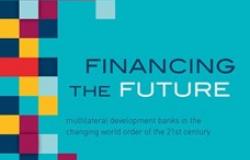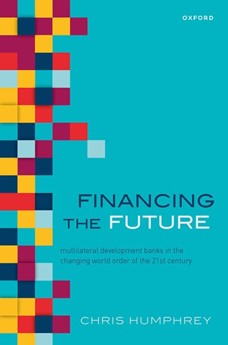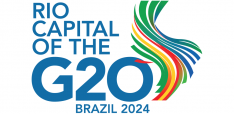Book Review - Financing the Future: Multilateral Development Banks in the Changing World Order of the 21st Century

Financing the Future: Multilateral Development Banks in the Changing World Order of the 21st Century by Chris Humphrey. Oxford: Oxford University Press 2022. 240 pp., £70 hardcover 9780192871503
Multilateral development banks—international organizations owned by at least three member states that borrow from financial markets to provide long-term loans for development—have proliferated in recent years and so has research on them. Despite their differences, MDBs have common features that make them amenable to comparison. This book examines the fundamentals of the ‘MDB model’ and its variations in over 30 MDBs. Importantly, the book illustrates how these design variations, which ultimately reflect the preferences of their sovereign founders, affect MDB operations, such as the composition of their loan portfolios, lending policies, and day-to-day politics.
Following a comprehensive introduction, the book explains in its first chapter how MDBs meet their financial needs. MDBs have many levers at their disposal to meet increasing financing needs for development: capital increases, loan pricing, portfolio (re)allocations to optimize risk-return profiles, and using retained earnings. All of these strategies involve challenges. For example, while capital increases are a tough sell to donors (and their domestic constituencies), increases in loan pricing are unpopular with borrowing countries, whereas taking greater risks clashes with the financial imperative to maintain excellent credit ratings. The next chapter focuses on governance. It distinguishes borrowing shareholders from non-borrowing shareholders. Both groups often disagree on key lending policies, for example, environmental and social safeguards. Whose preferences prevail depends on the de jure voting power of member countries as well as de facto power that arises from the policy leverage that especially the wealthier states have traditionally used through their control of concessional funding windows like the International Development Association (IDA) at the World Bank. The following chapters are comparative. They sketch the historical record of four legacy MDBs (the World Bank and the major regional development banks), borrower-led MDBs (like BSTDB, CAF, CDB, FONPLATA, and WADB), and the new challengers (AIIB and NDB), covering their financial model, their governance, and their operational profile. Each chapter serves as a plausibility probe for the analytical framework linking MDB governance, MDB financials, and MDB decisions. The chapters convincingly demonstrate how MDBs of the same type behave in similar ways. The concluding chapter sketches reform proposals for MDBs, urging policymakers to ‘get the governance right’ and equip MDBs with adequate capital to allow them to perform their developmental role.
 This book offers a fresh look at the increasingly crowded space of MDBs. While the book provides deep insights into several individual MDBs, its unique contribution is to consider MDBs as a species of development organizations that must be compared to fully understand them. This book is the first systematic effort to do so. Furthermore, it provides a sharp analytical lens that helps understand how MDBs behave. Backed by capital subscriptions from member states, MDBs enjoy excellent credit ratings that enables them to borrow cheaply from capital markets and to provide long-term loans to borrowing countries on attractive terms. However, MDBs can only provide loans at a low cost if they have an AAA credit rating, which depends on whether they can enlist financially top-rated member states such as the G7. This creates two types of MDBs: well-capitalized donor-driven MDBs with attractive financial terms but onerous policy prescriptions for borrowing governments; and poorly capitalized borrower-driven MDBs, which can offer neither attractive financial terms nor encompassing technical assistance but align with the development approach of their borrowers. The rise of China seems to support a third MDB type—epitomized by the AIIB and the NDB—that offers attractive financing for needs no longer served by the legacy MDBs, in the case of the NDB, without centralized safeguards. To undergird these arguments, the book draws on a wealth of evidence from both original interviews and secondary sources. Overall, this book is a must-have addition to the bookshelves of development policymakers and academics interested in international organizations and development.
This book offers a fresh look at the increasingly crowded space of MDBs. While the book provides deep insights into several individual MDBs, its unique contribution is to consider MDBs as a species of development organizations that must be compared to fully understand them. This book is the first systematic effort to do so. Furthermore, it provides a sharp analytical lens that helps understand how MDBs behave. Backed by capital subscriptions from member states, MDBs enjoy excellent credit ratings that enables them to borrow cheaply from capital markets and to provide long-term loans to borrowing countries on attractive terms. However, MDBs can only provide loans at a low cost if they have an AAA credit rating, which depends on whether they can enlist financially top-rated member states such as the G7. This creates two types of MDBs: well-capitalized donor-driven MDBs with attractive financial terms but onerous policy prescriptions for borrowing governments; and poorly capitalized borrower-driven MDBs, which can offer neither attractive financial terms nor encompassing technical assistance but align with the development approach of their borrowers. The rise of China seems to support a third MDB type—epitomized by the AIIB and the NDB—that offers attractive financing for needs no longer served by the legacy MDBs, in the case of the NDB, without centralized safeguards. To undergird these arguments, the book draws on a wealth of evidence from both original interviews and secondary sources. Overall, this book is a must-have addition to the bookshelves of development policymakers and academics interested in international organizations and development.
To be sure, research on MDBs, especially the new entrants, is fast-evolving. Readers who wish to dig deeper into specific aspects of MDB operations should take a look at a range of recent articles (Ella 2021; Heldt and Schmidtke 2019; Kellerman 2019; Kring and Gallagher 2019). For example, in an endogenous account of MDB creation, borrower-led MDBs turn to wealthy non-borrowing members when they face financial struggles, which dilutes their mission and then trigger the creation of new borrower-led MDBs (Kellerman 2019). This account complements the functionalist logic advanced by the book, which argues that the ‘MDB model’ has spread because it is useful. In addition, while it may be too early to say whether AIIB loan allocations advance Chinese foreign policy interests, some recent studies have attempted to rigorously address this issue by examining who gets access to AIIB loans (Kaya, Kilby, and Kay 2021), and whether AIIB projects are located near the Chinese Belt and Road (Kaya, Kilby, and Pan 2022). Researchers have also cast light on the motivations for different states to join the AIIB (Vieira 2018), analyzed whether institutional provisions reflect geostrategic donor interests (Ella 2021), and compared safeguards provisions across several MDBs (Apolinário Júnior and Jukemura 2022). These studies complement the findings of the book by offering rigorous analyses of specific aspects of MDB operations.
While MDBs can be fruitfully studied as a species, it is sometimes difficult to draw the boundaries. The book selects MDBs that support public-sector borrowers in lower-middle income countries. This seems like a defendable choice, although some cases are difficult to place. For example, the EBRD mostly provides private-sector loans, and ECOWAS Bank is heavily engaged in trade finance (Peitz 2022). At the same time, some interesting cases are excluded. For example, the EIB, the largest MDB in the world, in fact undertakes operations outside EU countries, too (Bougrea, Orbie, and Vermeiren 2022; Clifton, Díaz-Fuentes, and Gómez 2018; Coppolaro and Kavvadia 2022). While the EIB may be excluded because borrowers are not represented in the EIB governance structure, the EIB can arguably be seen as an extreme case of donor-driven MDBs. In some respects, the EIB is similar to national development banks, which as a species would merit a book of its own (Marois 2021; Mertens and Thiemann 2017). These banks have increasingly internationalized their operations, through co-financing of projects and collective lobbying for their interests, for instance, through the EDFI.
Finally, the findings of the book suggest some fruitful avenues for future research. One avenue highlighted in the book refers to capital adequacy standards for MDBs. Re-regulating how credit rating agencies evaluate MDB creditworthiness could unlock more investible capital. What holds back reforms on this issue? Progress is needed, also in light of the continued rise of China (Heldt and Schmidtke 2019; Hernandez 2017; Kern and Reinsberg 2022). China rivals the preferred creditor treatment of MDBs because its loan contracts include clauses that require borrowers to pay them back first (Gelpern et al. 2021). Hence, the continued relevance of MDBs—and not just the AIIB—may hinge on the benevolence of China due to its bilateral decisions. While these considerations appear to relegate governance and policy design to second-order issues, the core claim of the book still stands: shareholders need to ‘get the governance right’ if they want fit-for-purpose MDBs.
A final avenue for future research concerns the development effectiveness of different institutional features and policy provisions of MDBs. Does it matter how MDBs are governed? Does it matter where and how they engage? Existing evidence tends to be based on single MDBs—typically the World Bank (Heinzel 2022; Heinzel and Liese 2021; Limodio 2018)—but comparative studies across MDBs are still scarce due to both data limitations and methodological challenges (Honig, Lall, and Parks 2022). In taking a comparative angle, future studies should follow the lead of this book. The task is crucially important, given that more MDBs will see the light of day. Qualitative insights should be combined with rigorous large-N research to examine the effectiveness of specific operational practices, such as lending terms, policy conditions, safeguards provisions, and complementary grant financing, including from trust funds (Heinzel, Cormier, and Reinsberg 2023). Analyses should also scrutinize the viability of certain financial practices, such as legacy MDB investments in borrower-led MDBs and financial market operations whereby MDBs seek to achieve returns beyond their operations.
Dr. Bernhard Reinsberg is a Reader in Politics and International Relations in the School of Social and Political Sciences at the University of Glasgow, and a Research Associate in Political Economy at the Centre for Business Research at the University of Cambridge.
References
Apolinário Júnior, Laerte, and Felipe Jukemura. 2022. “A Comparative Analysis of the Environmental and Social Policies of the AIIB and World Bank.” Global Policy (July): 694–709.
Bougrea, Anissa, Jan Orbie, and Mattias Vermeiren. 2022. “The New European Financial Architecture for Development: Change or Continuity?” European Foreign Affairs Review 27(3): 337–60.
Clifton, Judith, Daniel Díaz-Fuentes, and Ana Lara Gómez. 2018. “The European Investment Bank: Development, Integration, Investment?” Journal of Common Market Studies 56(4): 733–50.
Coppolaro, Lucia, and Helen Kavvadia. 2022. Deciphering the European Investment Bank: History, Politics, and Economics. London: Routledge.
Ella, Doron. 2021. “Balancing Effectiveness with Geo-Economic Interests in Multilateral Development Banks: The Design of the AIIB, ADB and the World Bank in a Comparative Perspective.” Pacific Review 34(6): 1022–53. https://doi.org/10.1080/09512748.2020.1788628.
Gelpern, Anna et al. 2021. How China Lends: A Rare Look into 100 Debt Contracts with Foreign Governments.
Heinzel, Mirko. 2022. “International Bureaucrats and Organizational Performance. Country-Specific Knowledge and Sectoral Knowledge in World Bank Projects.” International Studies Quarterly 66(2): sqac013.
Heinzel, Mirko, Ben Cormier, and Bernhard Reinsberg. 2023. “Earmarked Funding and the Control−performance Tradeoff in International Development Organizations.” In ECPR Joint Sessions, Glasgow: University of Glasgow.
Heinzel, Mirko, and Andrea Liese. 2021. “Managing Performance and Winning Trust. How World Bank Staff Shapes Recipient Performance.” The Review of International Organizations 16(3): 625–53.
Heldt, Eugenia C, and Henning Schmidtke. 2019. “Global Democracy in Decline? How Rising Authoritarianism Limits Democratic Control over International Institutions.” Global Governance 25: 231–54.
Hernandez, Diego. 2017. “Are ‘New’ Donors Challenging World Bank Conditionality?” World Development 96: 529–49.
Honig, Dan, Ranjit Lall, and Bradley C. Parks. 2022. “When Does Transparency Improve Institutional Performance? Evidence from 20,000 Projects in 183 Countries.” American Journal of Political Science: forthcoming.
Kaya, Ayse, Christopher Kilby, and Jonathan Kay. 2021. “Asian Infrastructure Investment Bank as an Instrument for Chinese Influence? Supplementary versus Remedial Multilateralism.” World Development 145: 105531. https://doi.org/10.1016/j.worlddev.2021.105531.
Kaya, Ayse, Christopher Kilby, and Jingke Pan. 2022. Does Asian Infrastructure Investment Bank Lending Support China’s Belt & Road Initiative? A Subnational Analysis of Project Location.
Kellerman, Miles. 2019. “The Proliferation of Multilateral Development Banks.” Review of International Organizations 14(1): 107–45.
Kern, Andreas, and Bernhard Reinsberg. 2022. “The Political Economy of Chinese Debt and IMF Conditionality.” Global Studies Quarterly 2(4): ksac062.
Kring, William N, and Kevin P Gallagher. 2019. “Strengthening the Foundations? Alternative Institutions for Finance and Development.” Development and Change 50(1): 3–23.
Limodio, Nicola. 2018. “Bureaucrats Allocation in the Public Sector: Evidence from the World Bank.”
Marois, Thomas. 2021. Public Banks: Decarbonisation, Definancialisation and Democratisation. Cambridge: Cambridge University Press.
Mertens, Daniel, and Matthias Thiemann. 2017. “Building a Hidden Investment State? The European Investment Bank, National Development Banks and European Economic Governance.” Journal of European Public Policy 26(1): 23–43.
Peitz, Laura. 2022. Multilateral Development Banks: Mission, Business Model, Financial Management. Berlin. doi: 10.48462/opus4-4656.
Vieira, Vinícius Rodrigues. 2018. “Who Joins Counter-Hegemonic IGOs? Early and Late Members of the China-Led Asian Infrastructure Investment Bank.” Research and Politics 5(2): 2053168018770031.


